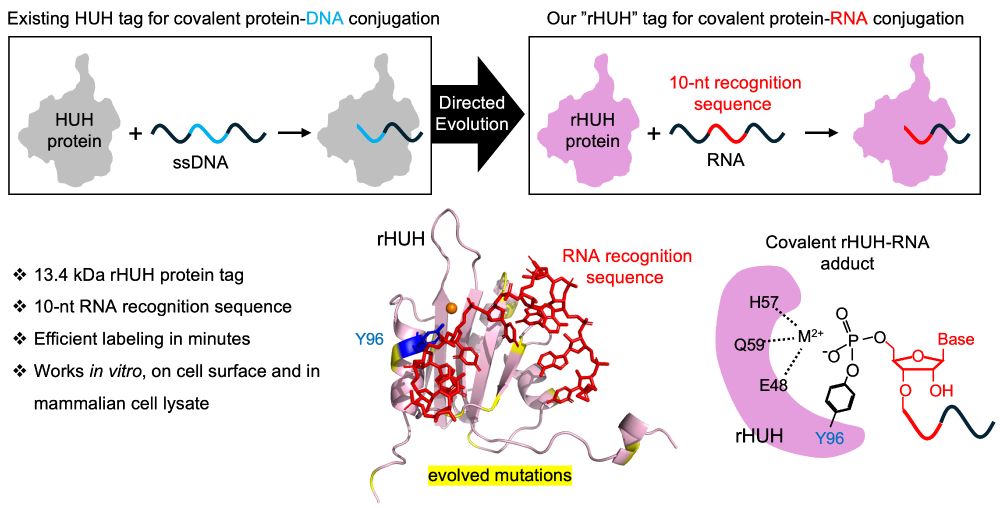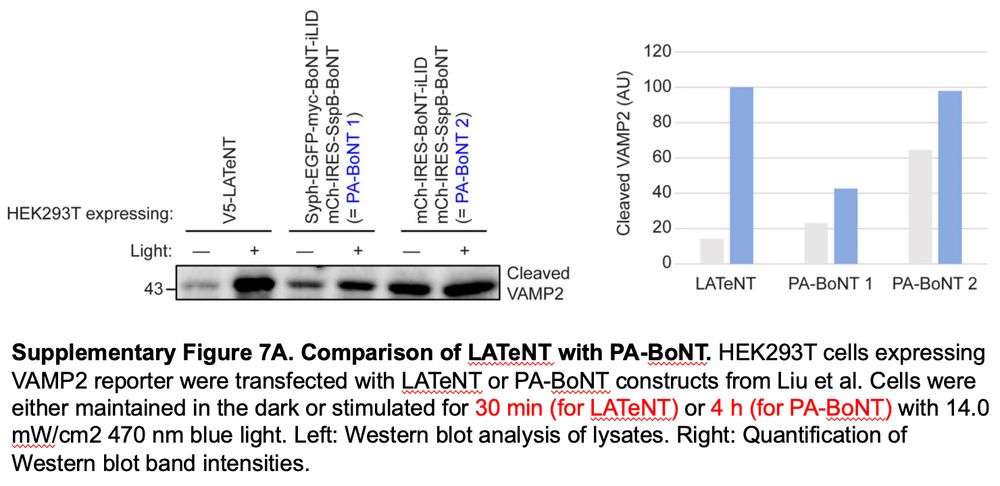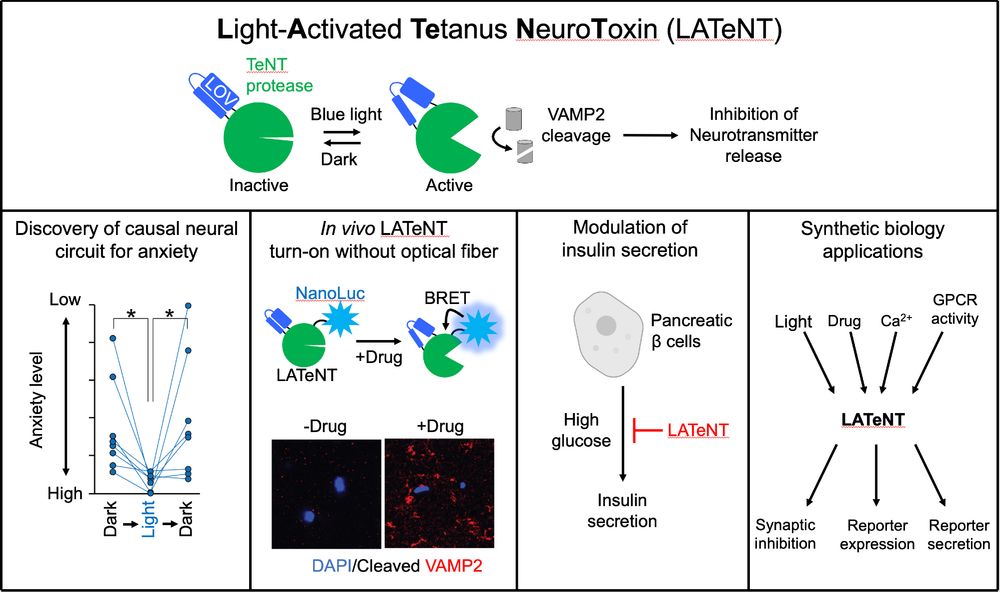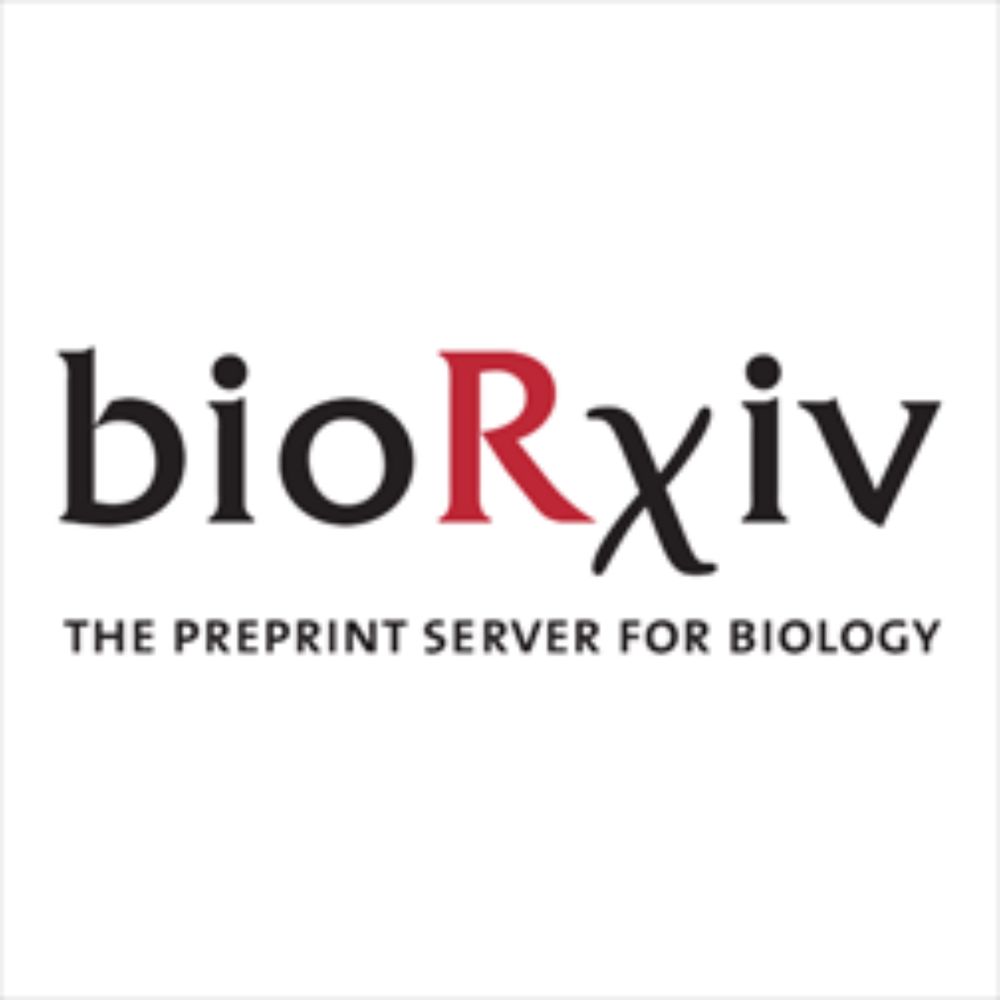
I'm thrilled to share our work from @weissmanlab.bsky.social (www.sciencedirect.com/science/arti...). We developed LOCL-TL, an optogenetic approach for monitoring localized translation in mammalian cells. LOCL-TL revealed two distinct strategies for mitochondrially localized translation.
27.08.2025 21:43 — 👍 17 🔁 6 💬 1 📌 1

LOV-BirA, light regulated biotin ligase, engineered by Song-Yi Lee
www.sciencedirect.com/science/arti...
27.08.2025 15:29 — 👍 22 🔁 7 💬 0 📌 2
Proximity-specific ribosome profiling using LOV-BirA reveals two distinct strategies for mitochondrially-localized translation: one for long coding sequences and one for short. It was a pleasure to contribute to this beautiful work from Jonathan Weissman @weissmanlab.bsky.social and Jingchuan Luo
27.08.2025 15:29 — 👍 32 🔁 7 💬 1 📌 2

LOV-BirA, light regulated biotin ligase, engineered by Song-Yi Lee
www.sciencedirect.com/science/arti...
27.08.2025 15:27 — 👍 0 🔁 0 💬 0 📌 0
LOV-BirA, light regulated biotin ligase, engineered by Song-Yi Lee
www.sciencedirect.com/science/arti...
27.08.2025 15:26 — 👍 8 🔁 2 💬 0 📌 0
Can a single researcher test over half a million chemical reactions in <3 days? Yes, using Jeff Martell’s new DNA-encoded combinatorial screening platform. Check out his lab’s exciting new preprint 👇
18.08.2025 16:06 — 👍 10 🔁 1 💬 0 📌 0
keeping the lab running (being a lab manager), and 50% is for original research related to protein engineering, technology development, etc – there are many project possibilities!
Seeking passionate, motivated, creative, and detail-oriented majors in chemical biology, molecular biology or related..
26.03.2025 17:39 — 👍 1 🔁 0 💬 1 📌 0
We are hiring a new lab manager! Our wonderful lab manager Albert is headed off to grad school and we are looking to fill his position this summer. This is a great opportunity for a new graduate to spend a couple years immersed in research before applying to PhD or MD programs. 50% of the job is...
26.03.2025 17:39 — 👍 17 🔁 8 💬 1 📌 0
and imperfect sequence specificity resulting in significant background labeling of endogenous transcripts.
There is still work to do for this to be a dream tool for RNA imaging/editing/mapping in living cells, but rHUH provides a good starting point and it is definitely good enough for in vitro
26.02.2025 23:22 — 👍 3 🔁 0 💬 1 📌 0
library diversification.
The final rHUH tag is 13.4 kD, has 12 mutations relative to HUH, and covalently labels as little as 1 nM target RNA within minutes. The labeling works well in mammalian cell lysate, but not yet in the interior of living cells – possibly due to the high Mg2+ requirement
26.02.2025 23:22 — 👍 3 🔁 0 💬 1 📌 0

Today we report the directed evolution of HUH into rHUH, a sequence-specific covalent protein tag for RNA labeling. rHUH was hard to engineer: the initial HUH template had no RNA activity, so we started with RNA-DNA hybrids. 30 rounds of selection on the yeast surface were required, and 7 cycles of
26.02.2025 23:21 — 👍 105 🔁 31 💬 3 📌 1
There is no detectable toxicity in the dark state because the protease activity is completely shut off. After activation, LATeNT only cleaves VAMP2, inhibiting synaptic transmission, but it does not affect other pathways. It does not kill cells.
31.01.2025 05:03 — 👍 1 🔁 0 💬 1 📌 0

Yes we did a side by side comparison to PA-BoNT in Figure S7A and found that PA-BoNT showed much lower +light activity and higher dark-state background than LATeNT
30.01.2025 16:44 — 👍 3 🔁 0 💬 1 📌 0

Very proud of amazing protein engineer Heegwang Roh, our fantastic neuroscience collaborator Ji Won Um, co-first author Dongwook Kim from the Um lab, and our other wonderful co-authors.
30.01.2025 14:37 — 👍 8 🔁 0 💬 1 📌 1
24 hours after shutting off LATeNT by taking away the light, anxiety levels returned to normal.
We are excited for neuroscientists to try this new tool! The inhibitory effect is stronger and more sustained than with other tools like halorhodopsin and DREADDs, but the timing and location of the...
30.01.2025 14:31 — 👍 1 🔁 0 💬 1 📌 0
Synaptic inhibition is potently inhibited only in those cells expressing LATeNT while neighboring cells are unaffected.
We used LATeNT in the mouse brain to discover a new cell population (SST+ interneurons in the hippocampus) that modulates anxiety.
30.01.2025 14:31 — 👍 1 🔁 0 💬 1 📌 0
we fused a light-sensitive LOV domain from oat plants into tetanus’ protease domain and made its activity controllable by light.
LATeNT (for light-activated tetanus neurotoxin) can be expressed in specific cell populations, and then turned on with a brief pulse of blue light.
30.01.2025 14:30 — 👍 1 🔁 0 💬 1 📌 0

Painting by Sir Charles Bell depicting opisthotonos, which can be caused by tetanus (1809)
Tetanus on demand! (not for bioweapons, but for neuroscience research)
Tetanus toxin induces paralysis by using a protease to cleave VAMP2, a protein required for synaptic vesicle fusion and neurotransmitter release.
To harness this toxicity and use it as a beneficial tool for neuroscience,
30.01.2025 14:30 — 👍 55 🔁 17 💬 2 📌 4

Global Science Scholars Postdoctoral Fellowship Program SS-F
Apply for the new international postdoctoral fellowship program from the CZ Biohub Network and Stellar Science Foundation.
...research labs that are part of the CZ Biohub network (including mine!).
See czbiohub.org/program-ssfc... to learn more and email me with any questions
Applications accepted on a rolling basis until March 27, 2025
09.01.2025 18:22 — 👍 0 🔁 0 💬 0 📌 0

Global Science Scholars Postdoctoral Fellowship Program SS-F
Apply for the new international postdoctoral fellowship program from the CZ Biohub Network and Stellar Science Foundation.
Are you a Japanese student interested in a postdoctoral fellowship in the US? The Chan Zuckerberg Initiative has an exciting new fully-funded Global Science Scholars program to pair students who have received their undergraduate or doctoral degrees in Japan with US bioengineering and biomedical...
09.01.2025 18:21 — 👍 7 🔁 5 💬 2 📌 0
activation migration, etc). This is discussed in the paper
04.12.2024 22:19 — 👍 1 🔁 0 💬 1 📌 0
CARs are much more restricted in both input scope (cell-attached antigens only) and output scope (immune activation only). PAGERs can respond to both soluble and cell-attached antigens and provide a wide range of outputs in response (transgene expression, real time fluorescence, inhibition,
04.12.2024 22:19 — 👍 5 🔁 0 💬 1 📌 0
Nick @nkalogriopoulos.bsky.social is on the job market this year and brimming over with creativity and deep experience. Nick did his PhD in GPCR structural bio. He is fearless, creative, rigorous, a great mentor and collaborator. His interests span synthetic bio, chem bio, and immunology.
04.12.2024 16:09 — 👍 14 🔁 1 💬 0 📌 0
Yulong Li Lab (@yulonglilab.bsky.social)
Yulong Li lab at Peking University
This work was co-led by two extraordinary postdocs, @nkalogriopoulos.bsky.social l & @reikatei.bsky.social. We had wonderful collabs with yulonglilab.bsky.social, Yuqi Yan, Ivan Soltesz & Peter Klein. In our lab, Matt Ravalin helped characterize PAGERs, and Bo Cai assisted with macrophage expts.
04.12.2024 16:08 — 👍 13 🔁 0 💬 2 📌 0
Synthetic receptors such as CARs and synNotch have revolutionized cell therapies and provided powerful tools for basic research. We hope that PAGERs will contribute new capabilities to these exciting fields as well.
04.12.2024 16:08 — 👍 12 🔁 0 💬 1 📌 0
in response, leading to increased tumor cell killing. In macrophage cultures, PAGER-TF shifted macrophages to an M1 anti-tumor state, in the presence of tumor or M2 markers. Lastly, we expressed PAGER-Gi in human primary T cells to program them to migrate towards a soluble antigen gradient.
04.12.2024 16:08 — 👍 9 🔁 0 💬 1 📌 0
A scientific journal devoted to publishing the most compelling research, opinion and analysis at the intersection of chemistry and biology.
Chemical biologist broadly defined
Assistant Professor at @UCSF_BTS | @HHMINEWS HGF | | Loving membrane proteins every day https://www.wcoyotelab.com
Husband, Father and grandfather, Datahound, Dog lover, Fan of Celtic music, Former NIGMS director, Former EiC of Science magazine, Stand Up for Science advisor, Pittsburgh, PA
NIH Dashboard: https://jeremymberg.github.io/jeremyberg.github.io/index.html
Postdoc @Stanford in the @aliceyting lab | Protein Engineering | Directed Evolution | Cellular Therapy
CEO and co-founder at Cyrus Bio. Co-founder OpenFold AI bio consortium. Computational protein/biologic discovery. Rare disease, auto-immune, anti-viral, vax. PhD Harvard Biophys, Postdoc Bakerlab at UW. #Urbanism, #bikes, #democracy, #proteinai
Stanford, cell cycle, RB, cancer, SCLC, mouse models
Surgeon, Writer ("Being Mortal," "Checklist Manifesto"), and formerly led Global Health @USAID.
Chief Data Scientist U of CA Health・Director, Bakar Computational Health Sci Institute・Distinguished Prof af UCSF・Entrepreneur・He/him・Opinions ⇨ my own
Synthetic biology and systems biology. https://www.elowitz.caltech.edu
Developing data intensive computational methods • PI @ Seoul National University 🇰🇷 • #FirstGen • he/him • Hauptschüler
Aging lab @Stanford. Our interests include mechanisms of aging, brain aging and rejuvenation, neural stem cell aging, genetics of lifespan and suspended animation in killifish
Machine learning for biology | Stanford and Arc Institute
Assistant Professor @ Stanford ChemE
synthetic biology, biomolecular engineering
https://gaolab.blog/
Dad, bioengineer, climber, skier, surfer (in that order, more or less).
Chaotic good alignment, or so my lab tells me...
Associate Prof of BME at BU
Synthetic mechanobiology, single molecules, molecular structure and engineering, bio-organic chemistry, and general enthusiast of science, kindness, and understanding.
www.thengolab.com










